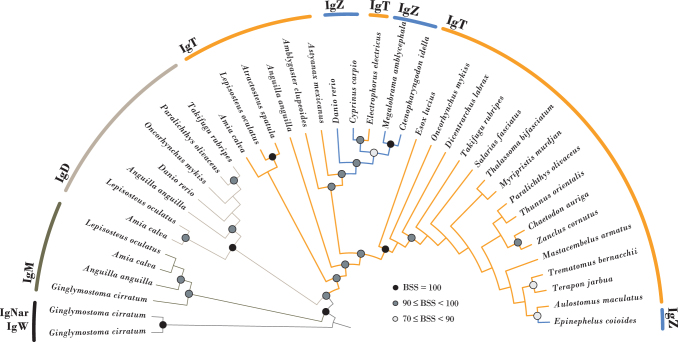From IgZ to IgT: A Call for a Common Nomenclature for Immunoglobulin Heavy Chain Genes of Ray-Finned Fish.
IF 1.2
4区 生物学
Q4 DEVELOPMENTAL BIOLOGY
引用次数: 5
Abstract
Ray-finned fishes comprise more than half the *60,000 known vertebrate species, and are pivotal to the functionality of aquatic ecosystems and success of global multibillion dollar industries. Understanding ray-finned fish immune systems is essential to predicting how species will respond to known or emergent pathogens as well as to the development of effective vaccines for aquaculture. However, the diversity of species, including in aquaculture, necessitates that immunology and translational medicine research groups investigating the immune system in one or a number of species employ a common language for describing homologous immune components. Unfortunately for Immunoglobulin (Ig) genes that encode antibodies, this has not been the case. Ig genes are restricted to jawed vertebrates (gnathostomes) with all lineages encoding common heavy chains IgM and IgD (aka IgW in cartilaginous fish, lungfish, and coelacanths). Before 2005, it was believed that bony fish encoded only IgM and IgD. In 2005, Hansen et al. described a new Ig heavy chain encoded within the rainbow trout heavy chain locus and named it IgT for ‘‘teleost.’’ However, during the

从IgZ到IgT:对鳐鱼免疫球蛋白重链基因统一命名的呼吁。
本文章由计算机程序翻译,如有差异,请以英文原文为准。
求助全文
约1分钟内获得全文
求助全文
来源期刊

Zebrafish
DEVELOPMENTAL BIOLOGY-ZOOLOGY
CiteScore
3.60
自引率
5.00%
发文量
29
审稿时长
3 months
期刊介绍:
Zebrafish is the only peer-reviewed journal dedicated to the central role of zebrafish and other aquarium species as models for the study of vertebrate development, evolution, toxicology, and human disease.
Due to its prolific reproduction and the external development of the transparent embryo, the zebrafish is a prime model for genetic and developmental studies. While genetically more distant from humans, the vertebrate zebrafish nevertheless has comparable organs and tissues, such as heart, kidney, pancreas, bones, and cartilage.
Zebrafish introduced the new section TechnoFish, which highlights these innovations for the general zebrafish community.
TechnoFish features two types of articles:
TechnoFish Previews: Important, generally useful technical advances or valuable transgenic lines
TechnoFish Methods: Brief descriptions of new methods, reagents, or transgenic lines that will be of widespread use in the zebrafish community
Zebrafish coverage includes:
Comparative genomics and evolution
Molecular/cellular mechanisms of cell growth
Genetic analysis of embryogenesis and disease
Toxicological and infectious disease models
Models for neurological disorders and aging
New methods, tools, and experimental approaches
Zebrafish also includes research with other aquarium species such as medaka, Fugu, and Xiphophorus.
 求助内容:
求助内容: 应助结果提醒方式:
应助结果提醒方式:


